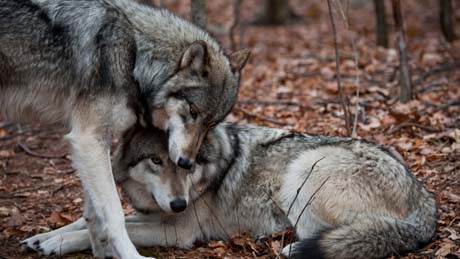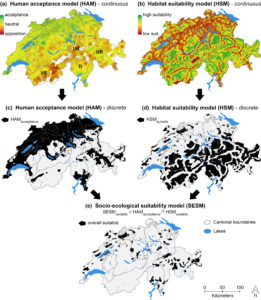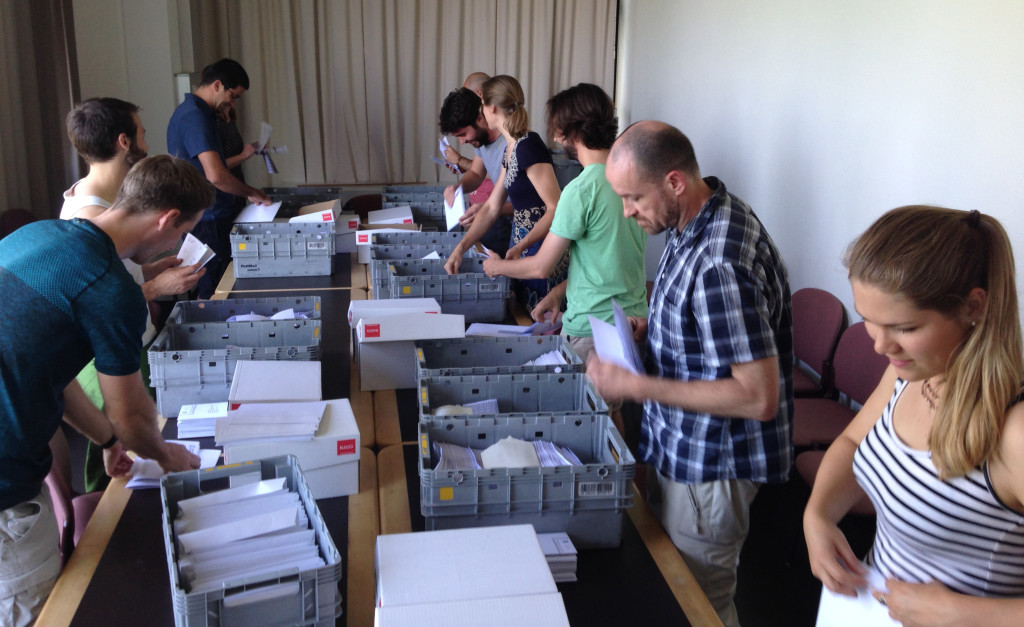The newspaper NZZ am Sonntag recently published an interview with our in-house predator specialist and movement ecology group leader Gabriele Cozzi about the current wolf situation in Switzerland and the associated research opportunities. The interview was conducted by Atlant Bieri and originally published in german. Below, we provide an english translation.
NZZ am Sonntag: Mr Cozzi, this summer a shepherdess and her dog were growled at by a wolf in Graubünden. There have also been more encounters between humans and wolves elsewhere recently. How dangerous is that?
Gabriele Cozzi: In such an encounter, a wolf possibly growls because it is frightened and thus signals its presence. In its language, this means: “Don’t come near me!” If you follow this signal, nothing can happen. In this situation, a wolf would only attack if it feels attacked and sees no escape options. But that hardly ever happens, you almost have to step on its tail.
As a defence, the woman called loudly and made herself appear as big as possible. The wolf then left. Does that always work?
She reacted correctly and used the language of the wolf. A loud voice is equivalent to growling. It means: “I am strong and could be a problem for you. You better leave me alone.” The louder you are, the more dangerous you appear to the wolf. For him, this means he could hurt himself unnecessarily if he attacks.
Is it also useful to stand up?
Yes, body size is important. In wolf language, it is synonymous with strength. That’s why you should not crouch or bend down to pick up stones as a weapon. It is better to move your hands above your head or to break branches from trees and waving them. But one should not directly attack the wolf. He might think that it is now too late to flee, and he must fight back.
Why is running away not a good idea?
It activates a hunting instinct in the wolf: the image of a fleeing prey. This can be observed very well in cats. A mouse dummy that does not move is ignored. Only when you let it slide across the floor does the cat’s hunting instinct kick in and it strikes. It’s the same with wolves. If I run away, I am the prey. In an encounter, the following message must always reach the wolf: a person is something big that is potentially strong and dangerous. Full stop. Then nothing will happen. You can walk slowly backwards, but always keep your eyes on the wolf without staring.
Why not?
Staring signals a challenge: whoever averts their gaze first submits. In an encounter, one should neither enter a competition nor be submissive, but rather remain calm and show self-confidence.
On another day, the same woman was surprised by three wolves at once. This time the animals attacked the woman’s dog. Why do wolves behave so aggressively towards dogs?
Wolves see dogs as nothing more than another wolf, but a wolf that is degenerate and weak. Moreover, he is an intruder in their territory. That is why dogs rather than their owners are attacked.
Sometimes, however, this also means that the dog is killed.
Yes, that can happen. Large predators are not squeamish about direct competition for food. It also happens that wolves kill other wolves. In Africa, lions kill hyenas without eating them afterwards. It is simply a matter of eliminating the competition. Basically, predators don’t like other predators.
In August, a group of hikers in Sufers came across two adult wolves that approached within a few metres. Later, the pups also followed the hikers. Why the approach and the subsequent pursuit?
In Africa, zebras are often seen walking directly towards a pride of lions. That means: “I see you and know what you’re doing.” It’s the same with wolves. Especially with parents, they may scout us to find out if we are a danger to the offspring.
With puppies it’s different. For them, everything is a game. They go after anything that moves. I have seen young African wild dogs chasing giraffes. This can be very dangerous for the young dogs, but they need to make experiences to understand it.
In North America, the authorities advise hiking tourists to always carry bear spray (pepper spray) with them. Would that also be conceivable in Switzerland?
Absolutely. It works very well in North America. All it takes there is a short blast and the wolf would takes off. Nobody likes to have pepper spray in their face. Using bear spray would only require a small change in our way of thinking. But maybe there is still some resistance at the moment.
Wolves seem to appear in settlements for no reason. Why?
You have to distinguish between migrating individuals and resident packs. Migrating individuals travel long distances every day and don’t really know where they are going. They don’t want to go to the city for sure. But in the densely populated landscapes, they only have to turn left once instead of right and they’re already in a village.
Packs, on the other hand, know their territories very well, and if they find something to eat near settlements, they are very likely to come back. This was a problem in Vättis, for example, where the Calanda pack often appeared. There, meat bait had been put out for fox hunting. The wolves quickly learned that they could easily get food here.
What does that mean for settlements?
Don’t leave food lying around. This can quickly lead to problems and unwanted encounters. In Turkey, where I researched bears and wolves, there is a town with a big rubbish dump. Bears and wolves come there every night to feed. It’s like a McDonald’s for them.
If wolves approach a settlement too often, they are declared problem wolves and can be shot. Would there be an alternative to this?
You can scare the animals away with rubber shot. But such measures, where the animals have to learn something, always take time. It is clear that this method would be very time-consuming for the gamekeepers and therefore not justifiable everywhere. Ultrasound could be used, similar to a cat or marten deterrent. In recent years, attempts have also been made to restrict the movements of predators by placing urine and droppings of conspecifics in strategic locations. We have to learn to be creative here.
Farmers in mountain areas have the same problem. They want to keep the wolf out of their pastures. Would there be more possibilities than fences and guard dogs?
We should try to exploit the technological possibilities. GPS transmitters, for example, could help to record the movements and preferred locations of resident packs. In the alpine region, packs have territories of about two hundred square kilometres. But certain locations are only heavily used during certain times of the year, such as the breeding season. The more information we have, the easier it will be to develop preventive measures.
There are currently about a hundred wolves in Switzerland, and the population is growing. Will more farm animals be killed every year?
The number of farm animals killed will probably increase. That is pure mathematics. But the number will not necessarily increase linearly: twice as many wolves does not necessarily mean twice as many lost farm animals. This because in Switzerland there are many wild animals such as deer, roe deer, chamois and wild boar, which play a much bigger role as prey than our sheep and goats.
But last year even a donkey was killed by wolves. Isn’t the situation deteriorating?
We should not condemn the wolf because of a donkey. At the end of the day, donkeys are part of its possible prey spectrum. It is important to maintain a rational mindset and take decisions based on facts and not emotions. Only in this way will the relationship between humans and wolves be sustainable.





